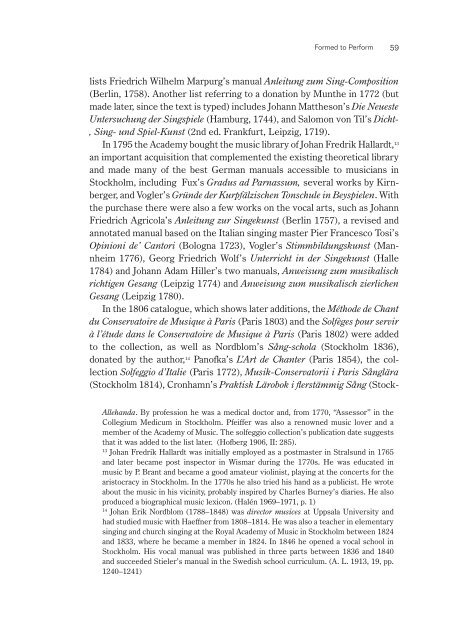Opera on the Move in the Nordic Countries during the Long 19th ...
Opera on the Move in the Nordic Countries during the Long 19th ...
Opera on the Move in the Nordic Countries during the Long 19th ...
Create successful ePaper yourself
Turn your PDF publications into a flip-book with our unique Google optimized e-Paper software.
Formed to Perform<br />
lists Friedrich Wilhelm Marpurg’s manual Anleitung zum S<strong>in</strong>g-Compositi<strong>on</strong><br />
(Berl<strong>in</strong>, 1758). Ano<strong>the</strong>r list referr<strong>in</strong>g to a d<strong>on</strong>ati<strong>on</strong> by Mun<strong>the</strong> <strong>in</strong> 1772 (but<br />
made later, s<strong>in</strong>ce <strong>the</strong> text is typed) <strong>in</strong>cludes Johann Mat<strong>the</strong>s<strong>on</strong>’s Die Neueste<br />
Untersuchung der S<strong>in</strong>gspiele (Hamburg, 1744), and Salom<strong>on</strong> v<strong>on</strong> Til’s Dicht-<br />
, S<strong>in</strong>g- und Spiel-Kunst (2nd ed. Frankfurt, Leipzig, 1719).<br />
In 1795 <strong>the</strong> Academy bought <strong>the</strong> music library of Johan Fredrik Hallardt, 13<br />
an important acquisiti<strong>on</strong> that complemented <strong>the</strong> exist<strong>in</strong>g <strong>the</strong>oretical library<br />
and made many of <strong>the</strong> best German manuals accessible to musicians <strong>in</strong><br />
Stockholm, <strong>in</strong>clud<strong>in</strong>g Fux’s Gradus ad Parnassum, several works by Kirnberger,<br />
and Vogler’s Gründe der Kurpfälzischen T<strong>on</strong>schule <strong>in</strong> Beyspielen. With<br />
<strong>the</strong> purchase <strong>the</strong>re were also a few works <strong>on</strong> <strong>the</strong> vocal arts, such as Johann<br />
Friedrich Agricola’s Anleitung zur S<strong>in</strong>gekunst (Berl<strong>in</strong> 1757), a revised and<br />
annotated manual based <strong>on</strong> <strong>the</strong> Italian s<strong>in</strong>g<strong>in</strong>g master Pier Francesco Tosi’s<br />
Op<strong>in</strong>i<strong>on</strong>i de’ Cantori (Bologna 1723), Vogler’s Stimmbildungskunst (Mannheim<br />
1776), Georg Friedrich Wolf’s Unterricht <strong>in</strong> der S<strong>in</strong>gekunst (Halle<br />
1784) and Johann Adam Hiller’s two manuals, Anweisung zum musikalisch<br />
richtigen Gesang (Leipzig 1774) and Anweisung zum musikalisch zierlichen<br />
Gesang (Leipzig 1780).<br />
In <strong>the</strong> 1806 catalogue, which shows later additi<strong>on</strong>s, <strong>the</strong> Méthode de Chant<br />
du C<strong>on</strong>servatoire de Musique à Paris (Paris 1803) and <strong>the</strong> Solfèges pour servir<br />
à l’étude dans le C<strong>on</strong>servatoire de Musique à Paris (Paris 1802) were added<br />
to <strong>the</strong> collecti<strong>on</strong>, as well as Nordblom’s Sång-schola (Stockholm 1836),<br />
d<strong>on</strong>ated by <strong>the</strong> author, 14 Panofka’s L’Art de Chanter (Paris 1854), <strong>the</strong> collecti<strong>on</strong><br />
Solfeggio d’Italie (Paris 1772), Musik-C<strong>on</strong>servatorii i Paris Sånglära<br />
(Stockholm 1814), Cr<strong>on</strong>hamn’s Praktisk Lärobok i flerstämmig Sång (Stock-<br />
Allehanda. By professi<strong>on</strong> he was a medical doctor and, from 1770, “Assessor” <strong>in</strong> <strong>the</strong><br />
Collegium Medicum <strong>in</strong> Stockholm. Pfeiffer was also a renowned music lover and a<br />
member of <strong>the</strong> Academy of Music. The solfeggio collecti<strong>on</strong>’s publicati<strong>on</strong> date suggests<br />
that it was added to <strong>the</strong> list later. (Hofberg 1906, II: 285).<br />
13 Johan Fredrik Hallardt was <strong>in</strong>itially employed as a postmaster <strong>in</strong> Stralsund <strong>in</strong> 1765<br />
and later became post <strong>in</strong>spector <strong>in</strong> Wismar dur<strong>in</strong>g <strong>the</strong> 1770s. He was educated <strong>in</strong><br />
music by P. Brant and became a good amateur viol<strong>in</strong>ist, play<strong>in</strong>g at <strong>the</strong> c<strong>on</strong>certs for <strong>the</strong><br />
aristocracy <strong>in</strong> Stockholm. In <strong>the</strong> 1770s he also tried his hand as a publicist. He wrote<br />
about <strong>the</strong> music <strong>in</strong> his vic<strong>in</strong>ity, probably <strong>in</strong>spired by Charles Burney’s diaries. He also<br />
produced a biographical music lexic<strong>on</strong>. (Halén 1969–1971, p. 1)<br />
14 Johan Erik Nordblom (1788–1848) was director musices at Uppsala University and<br />
had studied music with Haeffner from 1808–1814. He was also a teacher <strong>in</strong> elementary<br />
s<strong>in</strong>g<strong>in</strong>g and church s<strong>in</strong>g<strong>in</strong>g at <strong>the</strong> Royal Academy of Music <strong>in</strong> Stockholm between 1824<br />
and 1833, where he became a member <strong>in</strong> 1824. In 1846 he opened a vocal school <strong>in</strong><br />
Stockholm. His vocal manual was published <strong>in</strong> three parts between 1836 and 1840<br />
and succeeded Stieler’s manual <strong>in</strong> <strong>the</strong> Swedish school curriculum. (A. L. 1913, 19, pp.<br />
1240–1241)<br />
59
















